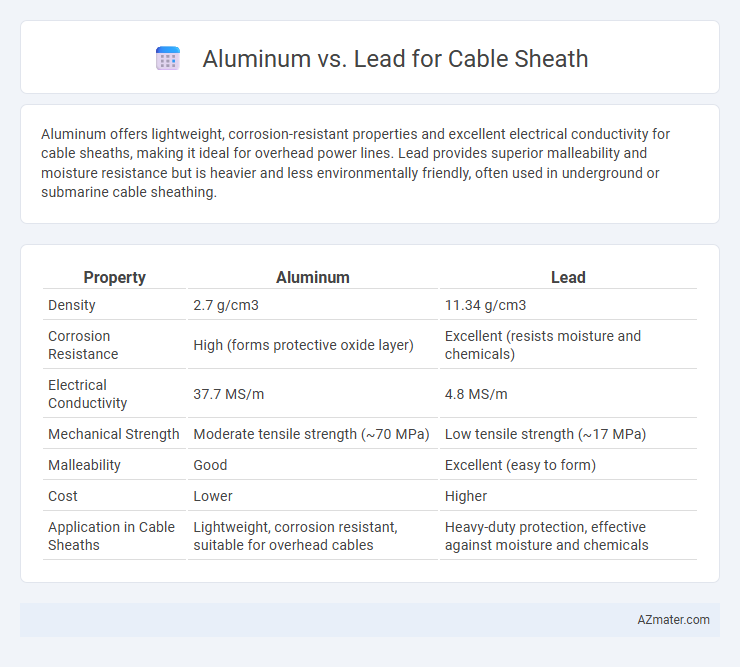Aluminum offers lightweight, corrosion-resistant properties and excellent electrical conductivity for cable sheaths, making it ideal for overhead power lines. Lead provides superior malleability and moisture resistance but is heavier and less environmentally friendly, often used in underground or submarine cable sheathing.
Table of Comparison
| Property | Aluminum | Lead |
|---|---|---|
| Density | 2.7 g/cm3 | 11.34 g/cm3 |
| Corrosion Resistance | High (forms protective oxide layer) | Excellent (resists moisture and chemicals) |
| Electrical Conductivity | 37.7 MS/m | 4.8 MS/m |
| Mechanical Strength | Moderate tensile strength (~70 MPa) | Low tensile strength (~17 MPa) |
| Malleability | Good | Excellent (easy to form) |
| Cost | Lower | Higher |
| Application in Cable Sheaths | Lightweight, corrosion resistant, suitable for overhead cables | Heavy-duty protection, effective against moisture and chemicals |
Introduction to Cable Sheath Materials
Aluminum and lead are prominent materials used in cable sheaths, each offering unique protective properties. Aluminum sheaths provide excellent corrosion resistance, lightweight characteristics, and electrical conductivity, making them ideal for overhead and underground cables in diverse environments. Lead sheaths, known for superior flexibility and moisture resistance, are often employed in harsh or chemically aggressive conditions where long-term durability and protection against water ingress are critical.
Overview of Aluminum and Lead as Sheathing Options
Aluminum cable sheath provides lightweight, corrosion-resistant protection with high conductivity and excellent mechanical strength, making it suitable for underground and overhead power cables. Lead sheathing offers superior corrosion resistance, especially against moisture and soil chemicals, with flexibility and proven durability in harsh environments. Both materials ensure cable integrity, but aluminum's lower weight and cost contrast with lead's enhanced corrosion barriers.
Physical and Chemical Properties Comparison
Aluminum offers a lightweight and corrosion-resistant option for cable sheaths, contrasting with lead's higher density and superior malleability which enhances flexibility but increases weight. Chemically, aluminum forms a protective oxide layer that prevents further corrosion, while lead's resistance to moisture and chemicals provides excellent protection in harsh environments. Thermal conductivity is higher in aluminum, facilitating heat dissipation, whereas lead's lower conductivity contributes to improved electrical insulation and shielding.
Electrical Performance: Conductivity and Shielding
Aluminum offers higher electrical conductivity than lead, enabling more efficient current flow and reduced energy losses in cable sheaths. Lead provides superior shielding against electromagnetic interference (EMI) due to its dense atomic structure, effectively protecting signal integrity in sensitive environments. Cable applications requiring lightweight, cost-effective conductors often prefer aluminum, while those prioritizing robust EMI protection favor lead sheaths.
Corrosion Resistance and Environmental Durability
Aluminum cable sheaths offer superior corrosion resistance compared to lead, particularly in marine and industrial environments where exposure to moisture and chemicals is high. Aluminum forms a stable oxide layer that protects the underlying metal from further oxidation, enhancing environmental durability and lifespan. Lead, while historically used for its malleability and moisture resistance, is more susceptible to degradation in acidic or alkaline conditions, reducing its long-term reliability.
Weight, Flexibility, and Handling Differences
Aluminum cable sheaths weigh approximately 30-50% less than lead, significantly reducing overall cable weight for easier installation and transport. Aluminum offers superior flexibility compared to lead, allowing it to bend without cracking, which improves handling and durability in dynamic applications. Lead, while more rigid and heavier, provides excellent corrosion resistance and protection but can be cumbersome and less adaptable during installation.
Installation and Maintenance Considerations
Aluminum cable sheaths offer lightweight properties that simplify handling and reduce labor costs during installation compared to the heavier lead sheaths. Lead sheaths provide superior corrosion resistance and flexibility, which can decrease maintenance frequency in harsh environments despite more challenging installation due to their weight and softness. Choosing between aluminum and lead for cable sheaths depends on balancing ease of installation versus long-term durability and maintenance needs in specific operational conditions.
Cost Analysis: Aluminum vs Lead Sheathing
Aluminum cable sheathing offers a significant cost advantage over lead due to its lower material price and lighter weight, which reduces transportation and installation expenses. Lead, while providing superior corrosion resistance and shielding properties, is considerably more expensive and heavier, leading to higher overall project costs. Opting for aluminum sheathing can lower initial investment and maintenance expenses without compromising adequate protection in many cable applications.
Environmental Impact and Sustainability
Aluminum cable sheaths offer a more sustainable option compared to lead due to their lower toxicity and greater recyclability, reducing environmental harm and landfill waste. The extraction and processing of aluminum produce fewer toxic byproducts and have a smaller carbon footprint relative to lead mining, which involves hazardous materials and contamination risks. Using aluminum sheaths enhances long-term environmental safety and supports circular economy principles by enabling efficient recycling and reducing reliance on finite resources.
Industry Applications and Best Use Cases
Aluminum cable sheaths are widely preferred in industries requiring lightweight, corrosion-resistant materials, such as telecommunications, power distribution, and aerospace sectors due to their excellent conductivity and ease of installation. Lead sheaths offer superior protection against moisture and chemical exposure, making them ideal for underground and submarine cables in oil and gas pipelines or marine applications. Choosing between aluminum and lead depends on specific environmental factors and mechanical stress tolerance, with aluminum excelling in cost-effective, high-strength scenarios and lead providing enhanced durability in harsh conditions.

Infographic: Aluminum vs Lead for Cable Sheath
 azmater.com
azmater.com